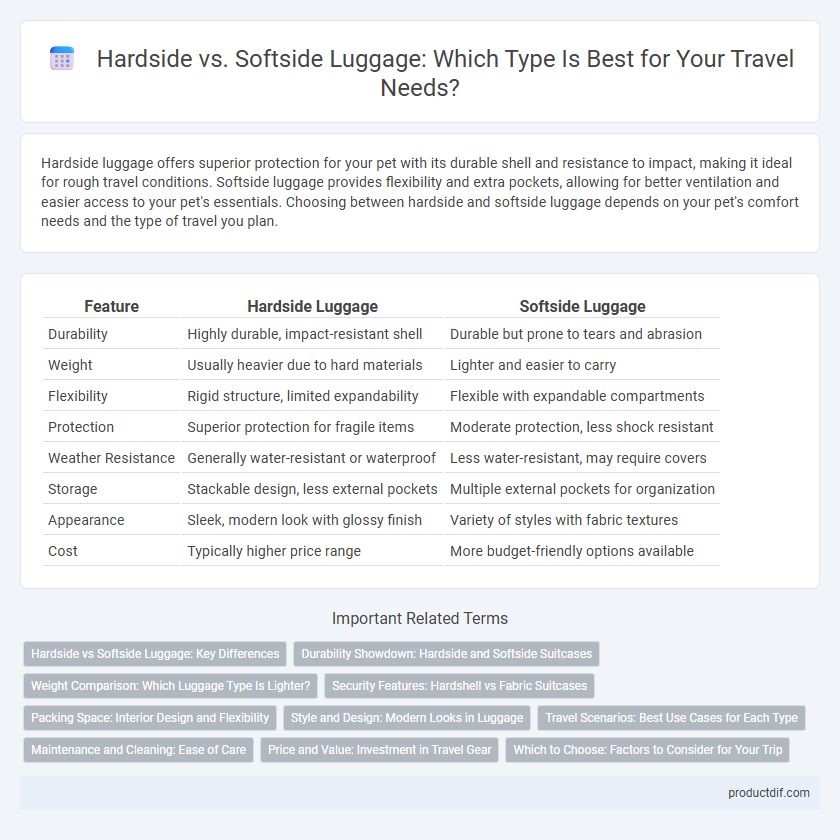Hardside luggage offers superior protection for your pet with its durable shell and resistance to impact, making it ideal for rough travel conditions. Softside luggage provides flexibility and extra pockets, allowing for better ventilation and easier access to your pet's essentials. Choosing between hardside and softside luggage depends on your pet's comfort needs and the type of travel you plan.
Table of Comparison
| Feature | Hardside Luggage | Softside Luggage |
|---|---|---|
| Durability | Highly durable, impact-resistant shell | Durable but prone to tears and abrasion |
| Weight | Usually heavier due to hard materials | Lighter and easier to carry |
| Flexibility | Rigid structure, limited expandability | Flexible with expandable compartments |
| Protection | Superior protection for fragile items | Moderate protection, less shock resistant |
| Weather Resistance | Generally water-resistant or waterproof | Less water-resistant, may require covers |
| Storage | Stackable design, less external pockets | Multiple external pockets for organization |
| Appearance | Sleek, modern look with glossy finish | Variety of styles with fabric textures |
| Cost | Typically higher price range | More budget-friendly options available |
Hardside vs Softside Luggage: Key Differences
Hardside luggage features a rigid outer shell made from materials like polycarbonate or ABS, offering superior protection against impacts and weather. Softside luggage is constructed from flexible fabrics such as nylon or polyester, providing expandable compartments and lighter weight for easier handling. Choosing between hardside and softside luggage depends on priorities like durability, weight, storage capacity, and the nature of travel.
Durability Showdown: Hardside and Softside Suitcases
Hardside suitcases offer superior durability with their rigid shells, effectively resisting impacts and protecting contents from external pressure and moisture. Softside suitcases, while less resistant to heavy impacts, provide flexibility and abrasion resistance, often incorporating water-resistant fabrics and reinforced corners for enhanced protection. Choosing between hardside and softside depends on travel conditions, with hardside excelling in rough handling scenarios and softside providing versatility and expandability.
Weight Comparison: Which Luggage Type Is Lighter?
Softside luggage is generally lighter than hardside luggage due to its fabric construction, typically using materials like ballistic nylon or polyester. Hardside luggage, made from polycarbonate or ABS plastic, tends to be heavier but offers enhanced durability and protection. Travelers prioritizing weight savings often choose softside options for easier handling and reduced airline fees.
Security Features: Hardshell vs Fabric Suitcases
Hardshell suitcases offer enhanced security with impact-resistant materials and integrated TSA-approved locks, providing superior protection against theft and damage. Softside luggage typically features external pockets with zipper locks for convenience but can be more vulnerable to tampering. For travelers prioritizing maximum security, hardside luggage with reinforced corners and tamper-proof zippers is the preferred choice.
Packing Space: Interior Design and Flexibility
Hardside luggage offers structured interior compartments with molded dividers, maximizing organized packing space but limiting flexibility for irregularly shaped items. Softside luggage features expandable, flexible fabric compartments and external pockets, allowing for adaptable packing and extra storage capacity. Travelers prioritizing efficient organization may prefer hardside, while those needing versatility and additional expansion opt for softside bags.
Style and Design: Modern Looks in Luggage
Hardside luggage features sleek, glossy exteriors with clean lines that appeal to travelers seeking a modern, polished style. Softside luggage offers versatile designs with fabric textures and multiple pockets, catering to those who prefer functional yet contemporary aesthetics. Both styles incorporate innovative color options and patterns, enhancing the visual appeal of modern travel gear.
Travel Scenarios: Best Use Cases for Each Type
Hardside luggage excels in travel scenarios requiring maximum protection for fragile items, such as business trips or international flights with multiple layovers. Softside luggage offers superior flexibility and external pockets, ideal for weekend getaways or road trips where easy access and expandability are prioritized. Choosing between hardside and softside depends on the need for durability against rough handling versus convenience and storage adaptability.
Maintenance and Cleaning: Ease of Care
Hardside luggage offers a smooth surface that resists stains and can be easily wiped clean with a damp cloth, making maintenance straightforward. Softside luggage requires regular fabric treatment and spot cleaning to prevent dirt buildup and stains due to its porous material. Choosing hardside luggage minimizes effort for upkeep, while softside options demand more frequent cleaning to maintain appearance and durability.
Price and Value: Investment in Travel Gear
Hardside luggage typically demands a higher upfront price, reflecting its durable construction and superior protection for fragile items. Softside luggage offers greater flexibility and often lower costs, making it a budget-friendly option for casual travelers. Evaluating long-term value involves assessing durability, warranty coverage, and the frequency of travel to determine the best investment in travel gear.
Which to Choose: Factors to Consider for Your Trip
Hardside luggage offers superior protection for fragile items and is typically more water-resistant, making it ideal for air travel and rough handling. Softside luggage provides greater flexibility, expandability, and lightweight convenience, suitable for trips requiring easy access and additional storage. Consider factors like trip duration, type of transportation, and personal packing habits to determine whether the rigidity or adaptability of your luggage best matches your travel needs.
Hardside vs Softside Infographic

 productdif.com
productdif.com